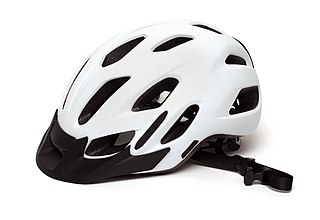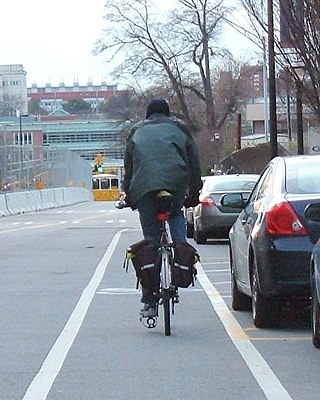
Critical Mass is a form of direct action in which people travel as a group on bicycles at a set location and time. The idea is for people to group together to make it safe for each other to ride bicycles through their streets, based on the old adage: there's safety in numbers.

A bicycle helmet is a type of helmet designed to attenuate impacts to the head of a cyclist in collisions while minimizing side effects such as interference with peripheral vision.
Australian vehicle registration plates or number plates are issued by state, territory, and Commonwealth governments, and the armed forces of Australia. The plates are associated with a vehicle and are generally intended to last for the time the vehicle remains registered in the state, though as they become unreadable they may be remade with like for like replacement. Motor vehicle registration in Australia can be renewed monthly, quarterly, half yearly or annually depending on the state or territory where the vehicle is registered.

Bicycle law in California is the parts of the California Vehicle Code that set out the law for persons cycling in California, and a subset of bicycle law in the United States. In general, pretty much all the same rights and responsibilities that apply to car drivers apply to bicycle riders as well.

Cycling in Melbourne is an important mode of transport, fitness, sport and recreation in many parts of the city. After a period of significant decline through the mid to late 20th century, additional infrastructure investment, changing transport preferences and increasing congestion has resulted in a resurgence in the popularity of cycling for transport. This is assisted by Melbourne's natural characteristics of relatively flat topography and generally mild climate.

Vehicular cycling is the practice of riding bicycles on roads in a manner that is in accordance with the principles for driving in traffic, and in a way that places responsibility for safety on the individual.

Dooring is the act of opening a motor vehicle door into the path of another road user. Dooring can happen when a driver has parked or stopped to exit their vehicle, or when passengers egress from cars, taxis and rideshares into the path of a cyclist in an adjacent travel lane. The width of the door zone in which this can happen varies, depending upon the model of car one is passing. The zone can be almost zero for a vehicle with sliding or gull-wing doors or much larger for a truck. In many cities across the globe, doorings are among the most common and injurious bike-vehicle incidents. Any passing vehicle may also strike and damage a negligently opened or left open door, or injure or kill the exiting motorist or passenger.

Non-motorized access on freeways may allow or restrict pedestrians, bicyclists and other non-motorized traffic to use a freeway. Such roads are public ways intended primarily for high-speed travel over long distances, and they have resulted in highways in the United States with engineering features such as long sight-distances, wide marked lanes and the absence of cross traffic. These provide faster and safer travel, at least for vehicles driving at similar speeds.

Bicycle safety is the use of road traffic safety practices to reduce risk associated with cycling. Risk can be defined as the number of incidents occurring for a given amount of cycling. Some of this subject matter is hotly debated: for example, which types of cycling environment or cycling infrastructure is safest for cyclists. The merits of obeying the traffic laws and using bicycle lighting at night are less controversial. Wearing a bicycle helmet may reduce the chance of head injury in the event of a crash.
Many countries have enacted electric vehicle laws to regulate the use of electric bicycles, also termed e-bikes. Some jurisdictions have regulations governing safety requirements and standards of manufacture. The members of the European Union and other regions have wider-ranging legislation covering use and safety.

A bridle path, also bridleway, equestrian trail, horse riding path, ride, bridle road, or horse trail, is a trail or a thoroughfare that is used by people riding on horses. Trails originally created for use by horses often now serve a wider range of users, including equestrians, hikers, and cyclists. Such paths are either impassable for motorized vehicles, or vehicles are banned. The laws relating to allowable uses vary from country to country.
Bicycle law in the United States is the law of the United States that regulates the use of bicycles. Although bicycle law is a relatively new specialty within the law, first appearing in the late 1980s, its roots date back to the 1880s and 1890s, when cyclists were using the courts to assert a legal right to use the roads. In 1895, George B. Clementson, an American attorney, wrote The Road Rights and Liabilities of Wheelmen, the first book on bicycle law, in which he discussed the seminal cases of the 1880s and 1890s, which were financed by Albert Pope of Columbia Bicycles, and through which cyclists gained the right to the road.

Cycling in Sydney, New South Wales, Australia takes place for recreation, commuting and as a sport. Sydney has a hilly topography and so may require a slightly higher level of fitness from cyclists than flatter cities such as Melbourne and Canberra. Sydney depends heavily on motor vehicles where traffic and public transport operate at capacity. This means that cyclist are often competing with motorists for limited space on busier roads, and for limited government resources for expenditure on road infrastructure. In its favour, Sydney has a generally mild climate and there are active cycling groups.
Cycling in Illinois encompasses recreation, bikeways, laws and rules, and advocacy. The director of the Illinois Department of Natural Resources, Joel Brunsvold, explained Illinois cycling opportunities: “Bicycle riding is one of the most popular outdoor recreational activities in Illinois, enjoyed by young and old alike...Illinois has a variety of trails for the public to enjoy. The terrain includes flat prairie land to rolling hills, towering bluffs to the breathtaking river and lakefront views.” Many communities across the state are updating bicycle infrastructure in order to accommodate the increased number of cyclists on the roads.
Cycling in the Australian state of New South Wales is a common form of recreation. In 2009, cycling was the fifth-most popular sports/physical activity in NSW.
Cycling in Australia is a common form of transport, recreation and sport.

Australia was the first country to make wearing bicycle helmets mandatory. The majority of early statistical data regarding the effectiveness of bicycle helmets originated from Australia. Their efficacy is still a matter of debate.

The Idaho stop is the common name for laws that allow bicyclists to treat a stop sign as a yield sign, and a red light as a stop sign. It first became law in Idaho in 1982, but was not adopted elsewhere until Delaware adopted a limited stop-as-yield law, the "Delaware Yield", in 2017. Arkansas was the second US state to legalize both stop-as-yield and red-light-as-stop in April 2019. Studies in Delaware and Idaho have shown significant decreases in crashes at stop-controlled intersections.

A personal transporter is any of a class of compact, mostly recent, motorised micromobility vehicle for transporting an individual at speeds that do not normally exceed 25 km/h (16 mph). They include electric skateboards, kick scooters, self-balancing unicycles and Segways, as well as gasoline-fueled motorised scooters or skateboards, typically using two-stroke engines of less than 49 cc (3.0 cu in) displacement. Many newer versions use recent advances in vehicle battery and motor-control technologies. They are growing in popularity, and legislators are in the process of determining how these devices should be classified, regulated and accommodated during a period of rapid innovation.

Cycling in the United States is a minor sport in the country. It is also a mode of transport, particularly in urban areas.















